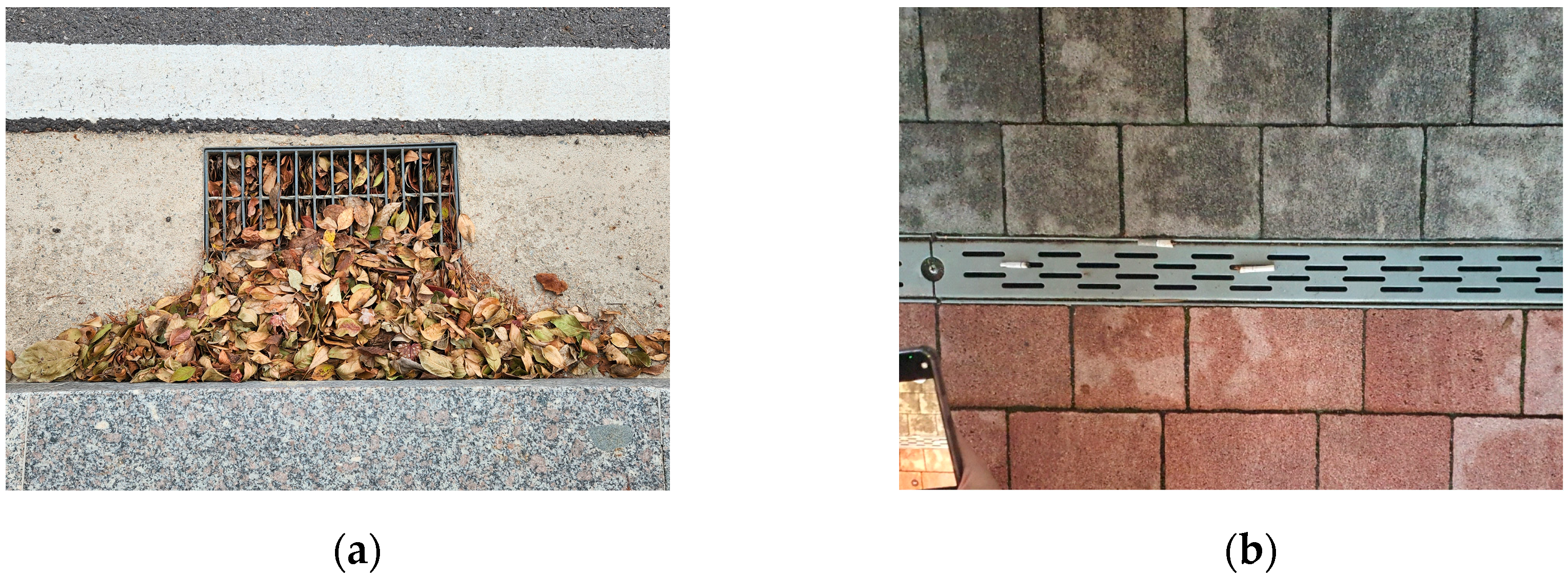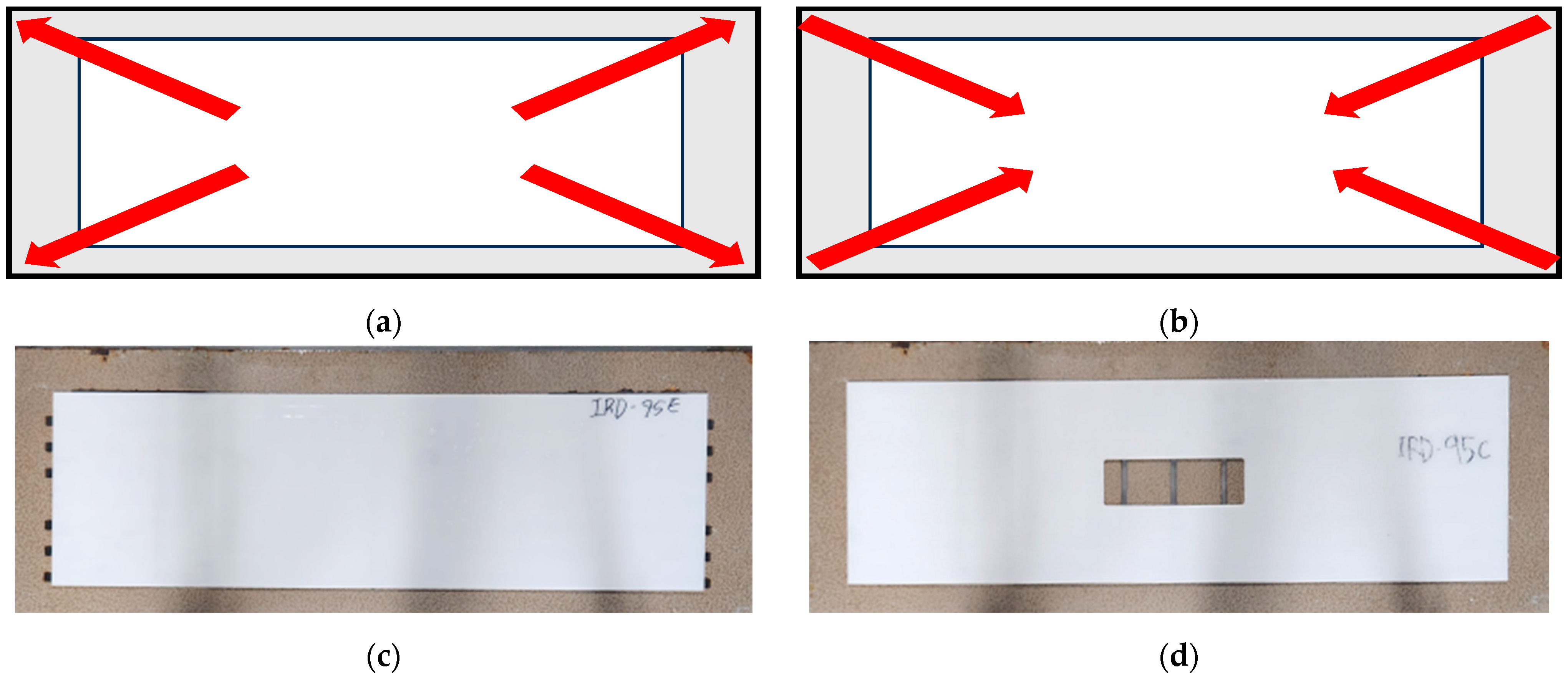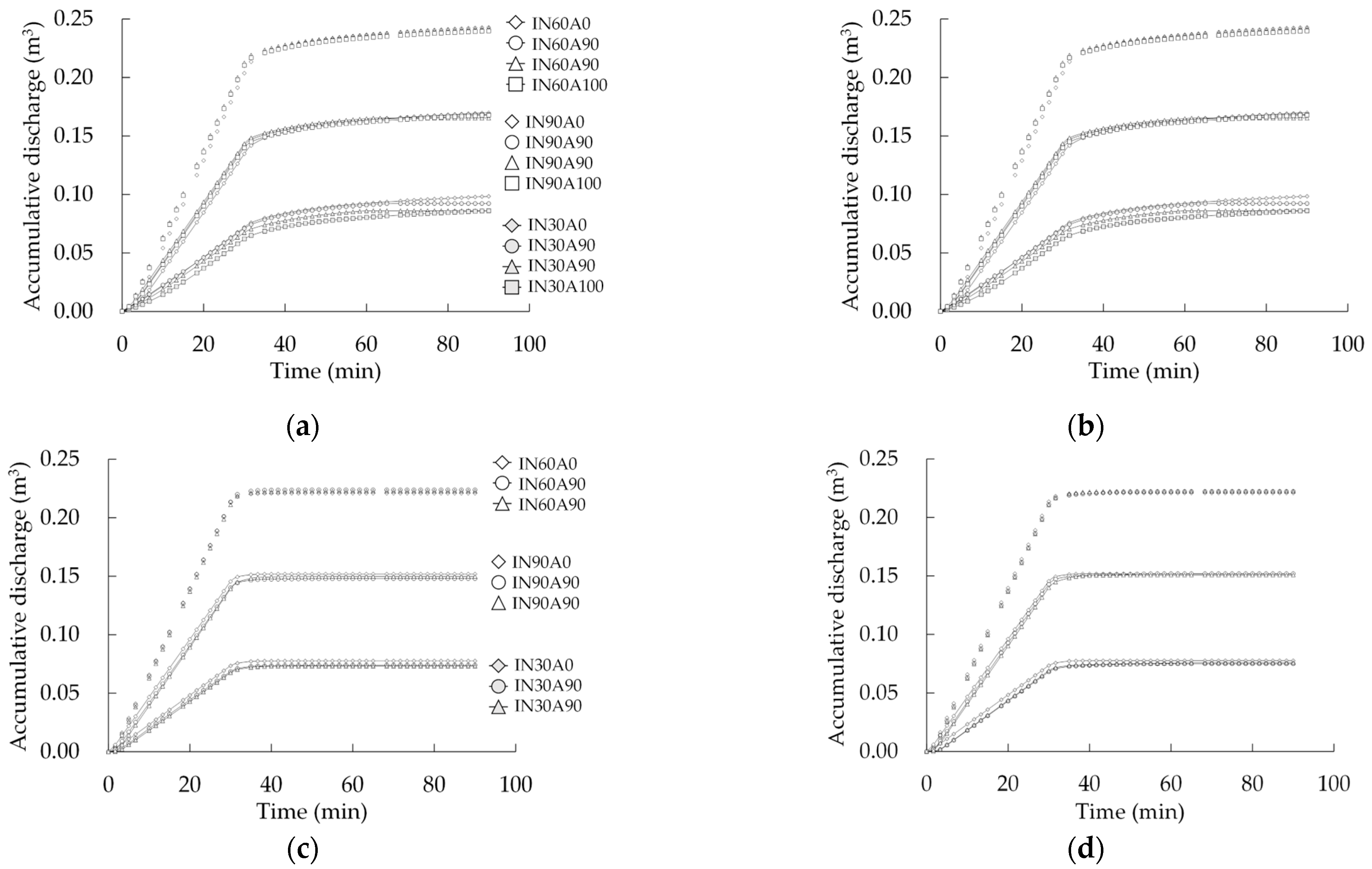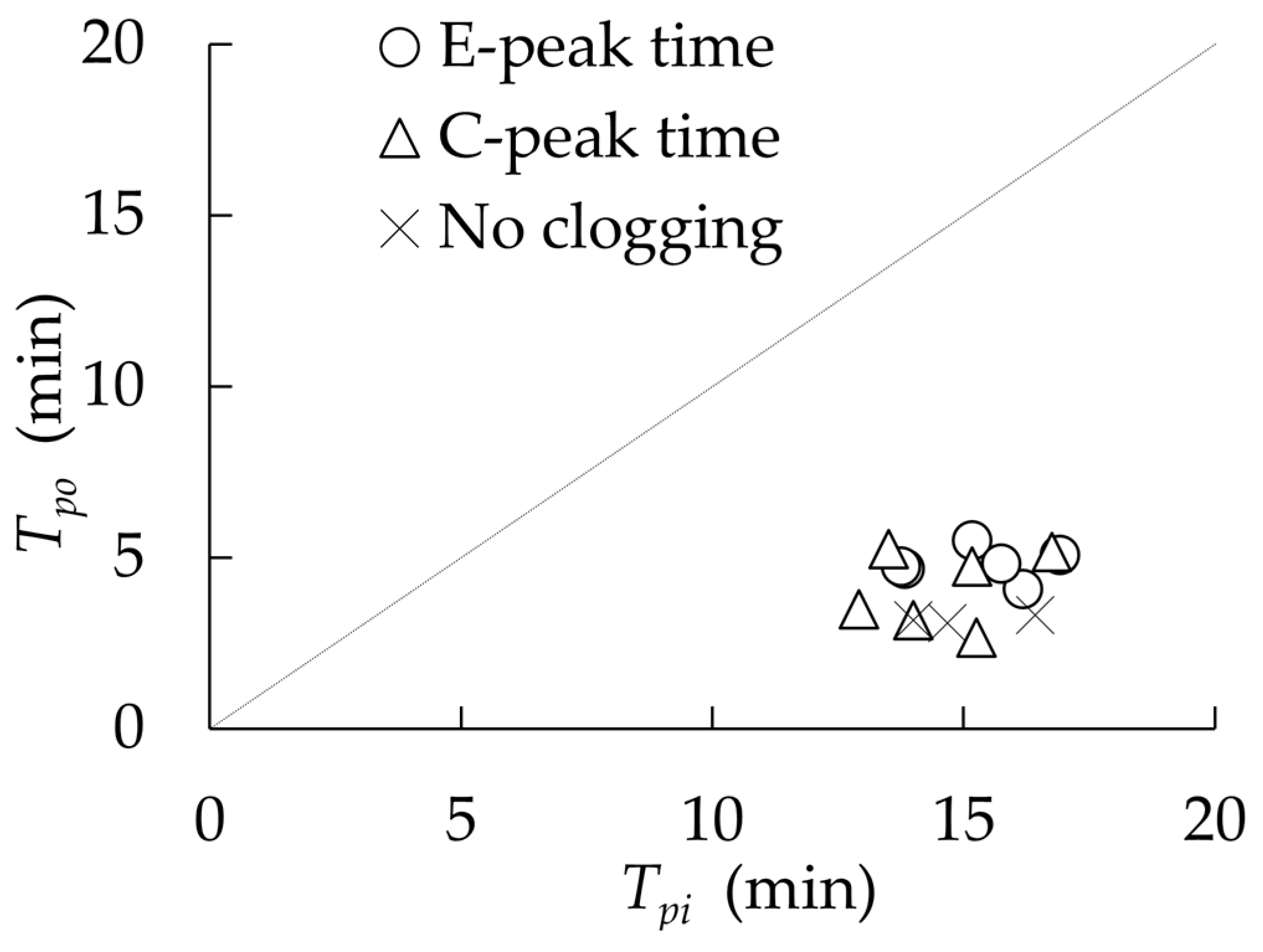An Experimental Study of the Retention Effect of Urban Drainage Systems in Response to Grate Inlet Clogging
Abstract
:1. Introduction
2. Materials and Methods
2.1. Physical Model
2.2. Experimental Procedure
3. Result
3.1. Surface Water Depth
3.2. Accumulative Discharge
3.3. Peak Discharge and Peak Time
3.4. Result of Experimental Study
4. Discussion
Author Contributions
Funding
Institutional Review Board Statement
Informed Consent Statement
Data Availability Statement
Conflicts of Interest
References
- Chang, I.-S.; Zhao, M.; Chen, Y.; Guo, X.; Zhu, Y.; Wu, J.; Yuan, T. Evaluation on the integrated water resources management in China’s major cities—Based on City Blueprint® Approach. J. Clean. Prod. 2020, 262, 121410. [Google Scholar] [CrossRef]
- Scholz, M.; Grabowiecki, P. Review of permeable pavement systems. Build. Environ. 2007, 42, 3830–3836. [Google Scholar] [CrossRef]
- Kim, J.S.; Kwon, I.S.; Yoon, S.E.; Lee, J.T. An Experimental Study for Clogging Factors Estimation of Grate Inlets in Urban Area. J. Korean Soc. Civ. Engineering. 2006, 26, 179–186. [Google Scholar]
- Yazdi, J.; Lee, E.H.; Kim, J.H. Stochastic Multiobjective Optimization Model for Urban Drainage Network Rehabilitation. J. Water Resour. Plannning Manag. 2015, 141, 04014091. [Google Scholar] [CrossRef]
- Zhou, Q. A Review of Sustainable Urban Drainage Systems Considering the Climate Change and Urbanization Impacts. Water 2014, 6, 976–992. [Google Scholar] [CrossRef]
- Graham, A.; Day, J.; Bray, B.; Mackenzie, S. Sustainable Drainage Systems: Maximizing the Potential for People and Wildlife; RSPB: Sandy, UK, 2012; Available online: https://www.wwt.org.uk/uploads/documents/2019-07-22/1563785657-wwt-rspb-sustainable-drainage-systems-guide.pdf (accessed on 28 June 2024).
- Prince George’s County, Maryland, Department of Environmental Resources, Programs and Planning Division. Low-Impact Development Design Strategies. 1999. Available online: https://www.princegeorgescountymd.gov/sites/default/files/media-document/dcv86_low-impact-development-design-strategies-pdf.pdf (accessed on 28 June 2024).
- Loc, H.H.; Duyen, P.M.; Ballatore, T.J.; Lan, N.H.M.; Gupta, A.D. Applicability of sustainable urban drainage systems: An evaluation by multi–criteria analysis. Env. Syst. Decis. 2017, 37, 332–343. [Google Scholar] [CrossRef]
- Bouarafa, S.; Lassabatere, L.; Lipeme–Kouyi, G.; Angulo–Jaramillo, R. Hydrodynamic Characterization of Sustainable Urban Drainage Systems (SuDS) by Using Beerkan Infiltration Experiments. Water 2019, 11, 660. [Google Scholar] [CrossRef]
- Guptha, G.C.; Swain, S.; Al–Ansari, N.; Taloor, A.K.; Dayal, D. Assessing the role of SuDS in resilience enhancement of urban drainage system: A case study of Gurugram City, India. Urban Clim. 2022, 41, 101075. [Google Scholar] [CrossRef]
- Joshi, P.; Leitão, J.P.; Maurer, M.; Bach, P.M. Not all SuDS are created equal: Impact of different approaches on combined sewer overflows. Water Res. 2021, 191, 116780. [Google Scholar] [CrossRef]
- Abbott, C.L.; Comino-Mateos, L. In-situ hydraulic performance of a permeable pavement sustainable urban drainage system. J. Chart. Inst. Water Environ. Manag. 2003, 17, 187–190. [Google Scholar] [CrossRef]
- Gómez, M.; Parés, J.; Russo, B.; Martínez–Gomariz, E. Methodology to quantify clogging coefficients for grated inlets: Application to SANT MARTI catchment (Barcelona). J. Flood Risk Manag. 2019, 12, 1–12. [Google Scholar] [CrossRef]
- Almedeij, J.; Alsulaili, A.; Alhomoud, J. Assessment of grate sag inlets in a residential area based on return period and clogging factor. J. Environ. Manag. 2006, 79, 38–42. [Google Scholar] [CrossRef]
- Jang, S.J.; Song, I.J.; Kim, J.S.; Yoon, S.E. Design of Street Grate Inlets with Consideration of Clogging Condition. J. Korean Soc. Civ. Eng. 2006, 26, 1251–1255. [Google Scholar]
- Baek, S.-Y.; Kim, H.-W.; Kim, M.-K.; Han, M.-Y. Runoff Reduction Effect of Rainwater Retentive Green Roof. J. Korean Inst. Ecol. Archit. Environ. 2016, 16, 67–71. [Google Scholar]
- Hong, T.; Ji, C. Comparison of the CO2 Emissions of Buildings using Input–Output LCA Model and Hybrid LCA Model. J. Korea Constr. Eng. Manag. 2014, 15, 119–127. [Google Scholar]
- Yeom, S.; Lee, J.; Choi, I.; Kim, Y.; Ahn, J. Environmental and Economical Evaluation of Infiltration Type Rainwater Drainage System for Sustainable Development. J. Korea Acad. Ind. Coop. Soc. 2024, 25, 314–320. [Google Scholar]
- Ahn, J.; Yeom, S.; Park, S.; Nguyen, T.H.T. Evaluation of Infiltration Rainwater Drainage (IRD) System with Fully 3-D Numerical Simulation Approach. Appl. Sci. 2021, 11, 9144. [Google Scholar] [CrossRef]
- Kim, Y.W.; Hwang, Y.W.; Kim, Y.I.; Gong, Y.J.; Lim, S.N. Evaluation of Greenhouse Gas Emissions on Sustainable Rain Water Collection System. Korean J. Life Cycle Assess. 2018, 19, 1–13. [Google Scholar]
- Seong, H.; Rhee, D.S.; Park, I. Analysis of Urban Flood Inundation Patterns According to Rainfall Intensity Using a Rainfall Simulator in the Sadang Area of South Korea. Appl. Sci. 2020, 10, 1158. [Google Scholar] [CrossRef]
- Im, J.H.; Song, J.W.; Park, Y.J. An Experimental Study on Improvement of the Effect for Runoff Reducing Facilities Using Infiltration. J. Korean Soc. Civ. Eng. 2009, 10, 5–13. [Google Scholar]
- Alsubih, M.; Arthur, S.; Wright, G.; Allen, D. Experimental study on the hydrological performance of a permeable pavement. Urban Water J. 2017, 14, 427–434. [Google Scholar] [CrossRef]
- Russo, B.; Gómez Valentín, M.; Tellez–Álvarez, J. The Relevance of Grated Inlets within Surface Drainage Systems in the Field of Urban Flood Resilience: A Review of Several Experimental and Numerical Simulation Approaches. Sustainability 2021, 13, 7189. [Google Scholar] [CrossRef]
- Du, S.; Shi, P.; Van Rompaey, A.; Wen, J. Quantifying the impact of impervious surface location on flood peak discharge in urban areas. Nat. Hazards 2015, 76, 1457–1471. [Google Scholar] [CrossRef]
- Kim, T.-H.; Park, J.-H.; Choi, B.-H. Analysis of Rainfall Runoff Delay Effect of Vegetation Unit-type LID System through Rainfall Simulator–based Probable Rainfall Recreation. J. Korean Env. Res. Tech. 2019, 22, 115–124. [Google Scholar]












| Clogging Type | Rainfall Intensity, IN (mm/h) | Clogging Ratio, A (%) | Drainage System | |
|---|---|---|---|---|
| IRDs | OCs | |||
| Contraction, C | 30 | 0 90 95 100 | IN30A0 | IN30A0 |
| IN30A90E | IN30A90E | |||
| IN30A95E | IN30A95E | |||
| IN30A100 | - | |||
| IN60A0 | IN60A0 | |||
| IN60A90E | IN60A90E | |||
| 60 | IN60A95E | IN60A95E | ||
| IN60A100 | - | |||
| IN900A0 | IN900A0 | |||
| Expansion, E | IN90A90E | IN90A90E | ||
| IN90A95E | IN90A95E | |||
| IN90A100 | - | |||
| 90 | IN30A90C | IN30A90C | ||
| IN30A95C | IN30A95C | |||
| IN60A90C | IN60A90C | |||
| IN60A95C | IN60A95C | |||
| IN90A90C | IN90A90C | |||
| IN90A95C | IN90A95C | |||
| C | E | |||||
|---|---|---|---|---|---|---|
| IN | 30 | 60 | 90 | 30 | 60 | 90 |
| 90 | 6.0 | 7.0 | 7.0 | 4.5 | 4.0 | 7.0 |
| 95 | 7.0 | 7.0 | 7.5 | 7.0 | 7.0 | 7.5 |
| Case No. | E | C | ||
|---|---|---|---|---|
| Peak Discharge, Qpo (m3/s) | Peak Time, Tpo (min) | Peak Discharge, Qpo (m3/s) | Peak Time, Tpo (min) | |
| IN30A0 | 5.0010−5 | 3.17 | 5.0010−5 | 3.17 |
| IN30A90 | 5.0010−5 | 4.67 | 5.0010−5 | 5.17 |
| IN30A95 | 5.0010−5 | 4.08 | 5.0010−5 | 3.5 |
| IN60A0 | 1.0010−4 | 3.08 | 1.0010−4 | 3.08 |
| IN60A90 | 1.0010−4 | 4.75 | 1.0010−4 | 5.25 |
| IN60A95 | 1.0010−4 | 5.50 | 1.0010−4 | 2.67 |
| IN90A0 | 1.4010−4 | 3.33 | 1.4010−4 | 3.33 |
| IN90A90 | 1.4010−4 | 4.83 | 1.4010−4 | 4.75 |
| IN90A95 | 1.4010−4 | 5.08 | 1.4010−4 | 3.17 |
| Case No. | E | C | ||
|---|---|---|---|---|
| Peak Discharge, Qpi (m3/s) | Peak Time, Tpi (min) | Peak Discharge, Qpi (m3/s) | Peak Time, Tpi (min) | |
| IN30A0 | 5.0010−5 | 14.00 | 5.0010−5 | 14.00 |
| IN30A90 | 5.0010−5 | 13.83 | 5.0010−5 | 16.75 |
| IN30A95 | 5.0010−5 | 16.17 | 5.0010−5 | 12.92 |
| IN30A100 | 5.0010−5 | 18.25 | 5.0010−5 | 18.25 |
| IN60A0 | 1.0010−4 | 14.67 | 1.0010−4 | 14.67 |
| IN60A90 | 1.0010−4 | 13.75 | 1.0010−4 | 13.50 |
| IN60A95 | 1.0010−4 | 15.17 | 1.0010−4 | 15.25 |
| IN60A100 | 1.0010−4 | 13.17 | 1.0010−4 | 13.17 |
| IN90A0 | 1.4010−4 | 16.42 | 1.4010−4 | 16.42 |
| IN90A90 | 1.4010−4 | 15.75 | 1.4010−4 | 15.75 |
| IN90A95 | 1.4010−4 | 16.92 | 1.4010−4 | 16.92 |
| IN90A100 | 1.4010−4 | 15.00 | 1.4010−4 | 15.00 |
Disclaimer/Publisher’s Note: The statements, opinions and data contained in all publications are solely those of the individual author(s) and contributor(s) and not of MDPI and/or the editor(s). MDPI and/or the editor(s) disclaim responsibility for any injury to people or property resulting from any ideas, methods, instructions or products referred to in the content. |
© 2024 by the authors. Licensee MDPI, Basel, Switzerland. This article is an open access article distributed under the terms and conditions of the Creative Commons Attribution (CC BY) license (https://creativecommons.org/licenses/by/4.0/).
Share and Cite
Yeom, S.; Ahn, J. An Experimental Study of the Retention Effect of Urban Drainage Systems in Response to Grate Inlet Clogging. Sustainability 2024, 16, 7596. https://doi.org/10.3390/su16177596
Yeom S, Ahn J. An Experimental Study of the Retention Effect of Urban Drainage Systems in Response to Grate Inlet Clogging. Sustainability. 2024; 16(17):7596. https://doi.org/10.3390/su16177596
Chicago/Turabian StyleYeom, Seongil, and Jungkyu Ahn. 2024. "An Experimental Study of the Retention Effect of Urban Drainage Systems in Response to Grate Inlet Clogging" Sustainability 16, no. 17: 7596. https://doi.org/10.3390/su16177596
APA StyleYeom, S., & Ahn, J. (2024). An Experimental Study of the Retention Effect of Urban Drainage Systems in Response to Grate Inlet Clogging. Sustainability, 16(17), 7596. https://doi.org/10.3390/su16177596





